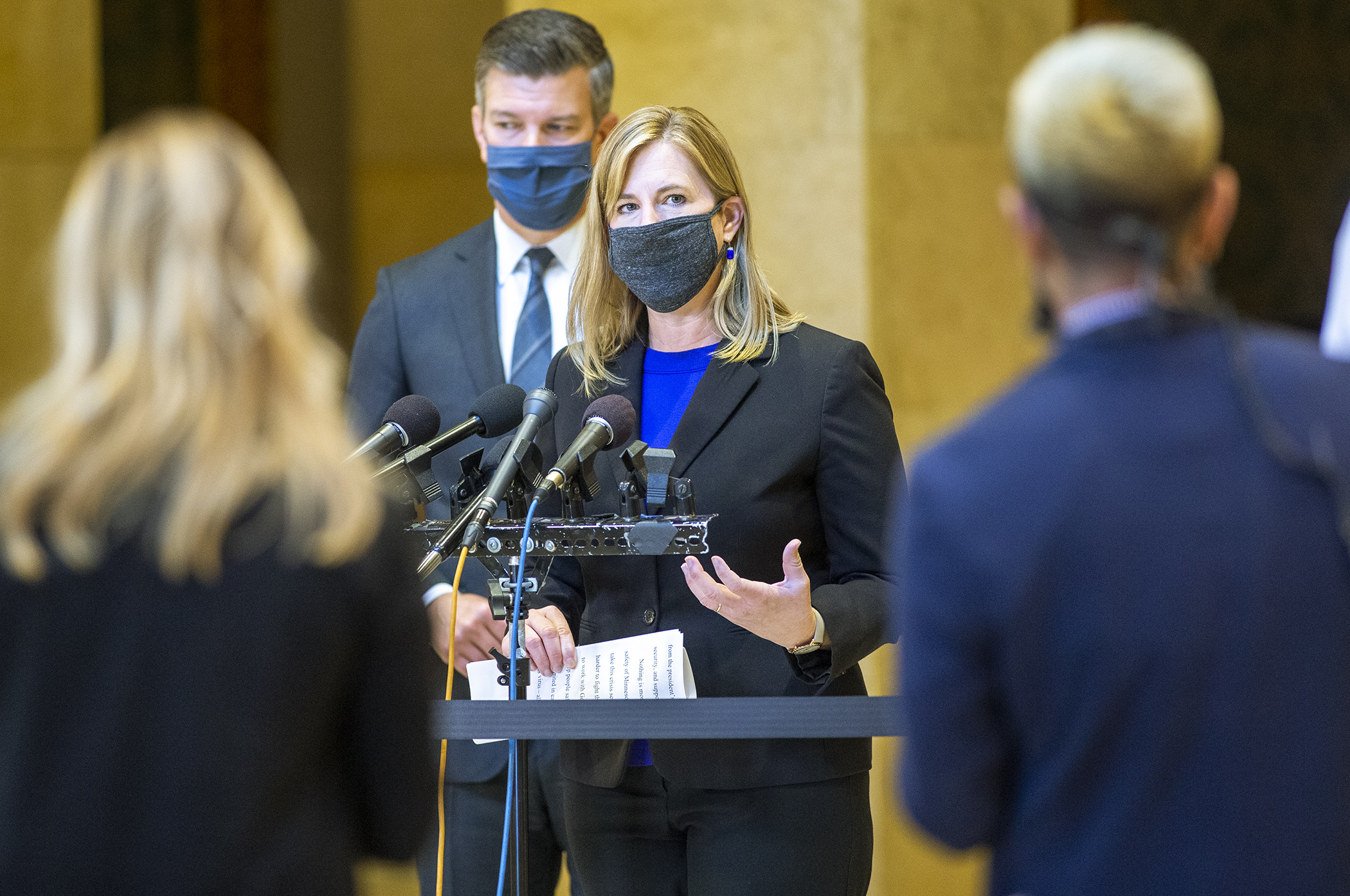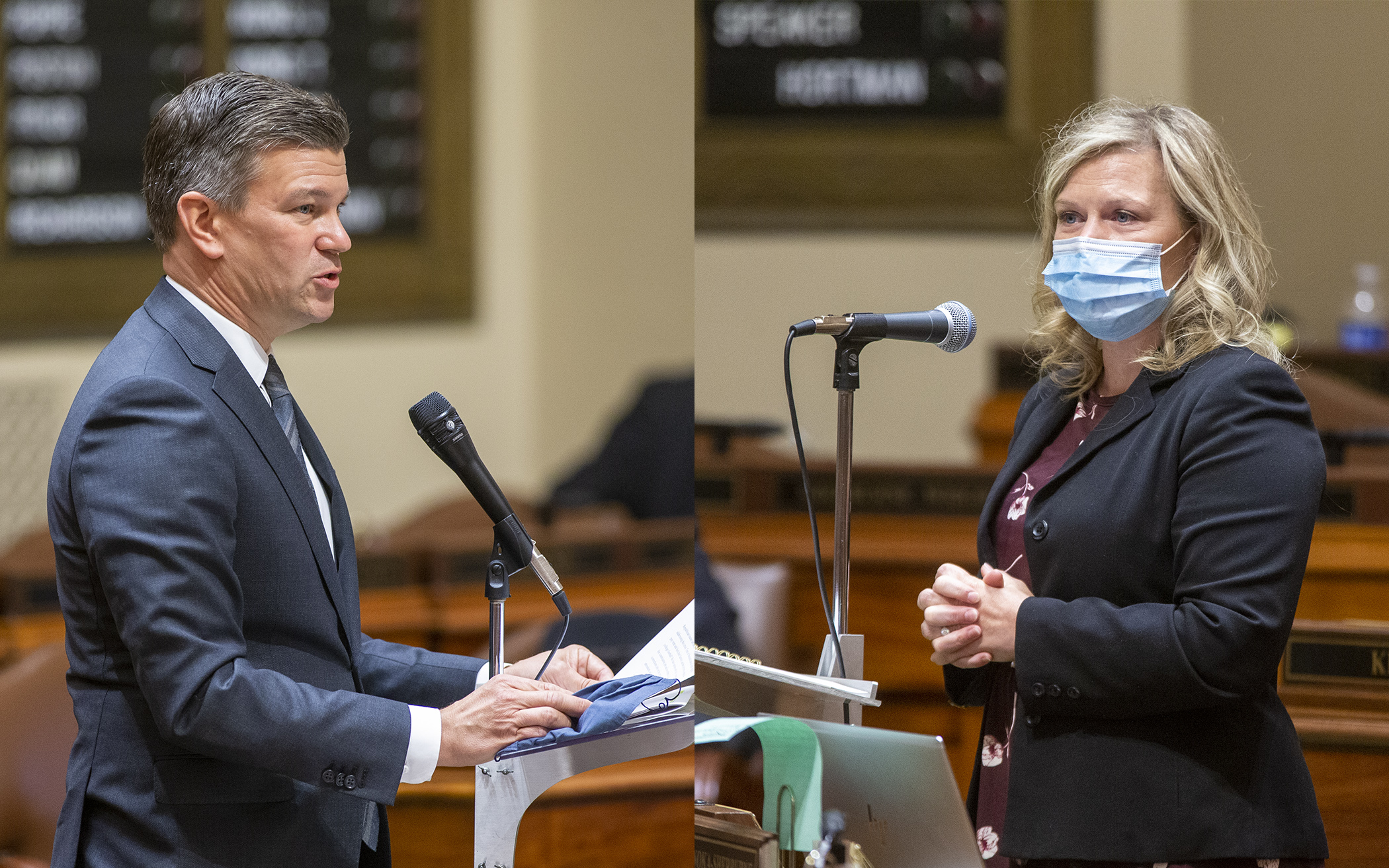House again backs governor's emergency powers in special session

On a historic day, the latest special session saw the House do what it did three times this summer.
Friday marked the first time there have been four special sessions in a calendar year, each prompted when the governor extended the state’s peacetime emergency by 30 days in response to the coronavirus pandemic.
Just like the June, July and August gatherings, the House voted against bringing up a concurrent resolution that would end Gov. Tim Walz’s peacetime emergency powers in response to the COVID-19 pandemic.
This time the vote was 67-64 after a sometimes heated, sometimes emotional, and at times highly partisan debate about suspending House rules that often strayed into other issues, including President Trump’s reaction to the pandemic and police funding.
The Senate voted 36-31 on Friday for a similar concurrent resolution.
“We need to stop the rhetoric and work together,” said Rep. John Huot (DFL-Rosemount).
Rep. Jim Nash (R-Waconia) said all 134 members have election certificates, yet Walz is making all the coronavirus calls in a system where the executive, legislative and judicial branches are all part of government.
“You have been given the ability to be the voice of the people in the state of Minnesota,” Nash said. “I encourage you to exercise that voice. I encourage you to take up the mantle of responsibility and be the people’s voice. … That third leg of the stool has been removed. Please, for the love of lutefisk, put it back.”
Added Rep. Glenn Gruenhagen (R-Glencoe): “It’s causing a huge amount of frustration to see the governor making these types of executive orders that affect businesses and people’s lives where their elected officials have no voice in it. … Let’s work together with the governor on a bipartisan basis.”
DFLers again argued the governor’s emergency power is needed to allow state officials to quickly respond to pandemic needs, such as temporarily limiting restaurant capacity or procuring personal protective equipment. They note the federal government has declared a national emergency and some form of a peacetime emergency exists in 48 other states — no matter the governor’s political party.
Rep. Hunter Cantrell (DFL-Savage) said he feels the “discomfort and anguish” many Minnesotans have felt, but the state needs to follow the science and not lose progress that has been made against the coronavirus.
“If we choose to end the peacetime emergency today, it doesn’t mean that the pandemic is over or that we will be able to return to life as we knew it before the pandemic, although I know we all want to,” he said. “To end the peacetime emergency today would eliminate a constitutionally sound tool to organize and coordinate our ongoing pandemic response.”
 During the fourth special session of the summer, House Majority Leader Ryan Winkler, left, and Rep. Anne Neu debate whether the House should vote on a resolution to end the governor’s peacetime emergency powers. Photos by Paul Battaglia
During the fourth special session of the summer, House Majority Leader Ryan Winkler, left, and Rep. Anne Neu debate whether the House should vote on a resolution to end the governor’s peacetime emergency powers. Photos by Paul BattagliaAt a morning meeting, the state’s Executive Council voted to extend the peacetime emergency through Oct. 12, 2020, or until the executive order is rescinded by proper authority or a majority vote of the House and Senate.
“We at the Department of Health recently reported the largest one-day increase in positive cases since this pandemic began,” Assistant Commissioner Daniel Huff told the council. “Over the past week, Minnesota has averaged 751 positive cases reported per day. This is an increase of 13% from the average of two weeks earlier.”
Nearly 1,900 Minnesotans have died from COVID-19.
“My top priority remains the health and safety of Minnesotans,” Walz said in a statement. “The COVID-19 pandemic is not over, and the next stages of this virus continue to threaten our state. Today we extend our peacetime emergency, giving Minnesota the tools to quickly respond to this rapidly-evolving virus as we approach the fall and winter.”
Back for bonding in 10 days?
At a pre-session news conference, House Speaker Melissa Hortman (DFL-Brooklyn Park) said work continues on a capital investment package with hopes of a positive vote later this month.
Following a mid-August bond sale, Minnesota is in a so-called “financial quiet period” until Sept. 20. Hortman has suggested to House Minority Leader Kurt Daudt (R-Crown) that a negotiation schedule be established so the Legislature can return Sept. 21 to act on a bill.
“I’m hopeful,” Hortman said. “These long overdue and necessary investments should be made this year and will be part of our recovery.”
The House failed to pass a $2 billion package in May and a $1.8 billion one in July. In each case, six Republican votes were not procured to get the statutorily required three-fifths majority (81 votes) to pass.
Addressing budget deficit can wait
In addition to a current biennial deficit of $2.4 billion, Minnesota faces a projected $4.7 billion deficit in the 2022-23 biennium. But there seems to be little urgency.
“We really need to get the full November forecast before we start doing the budget work and we need to have the election,” Hortman said. “We are a part-time citizen Legislature and the pandemic and these emergency special sessions have really taxed the capabilities of this institution, which is not designed to be a full-time legislative body. We’ll be back to business in January after the election with a very tall order of items to accomplish.”
Related Articles
Search Session Daily
Advanced Search OptionsPriority Dailies
Ways and Means Committee OKs proposed $512 million supplemental budget on party-line vote
By Mike Cook Meeting more needs or fiscal irresponsibility is one way to sum up the differences among the two parties on a supplemental spending package a year after a $72 billion state budg...
Meeting more needs or fiscal irresponsibility is one way to sum up the differences among the two parties on a supplemental spending package a year after a $72 billion state budg...
Minnesota’s projected budget surplus balloons to $3.7 billion, but fiscal pressure still looms
By Rob Hubbard Just as Minnesota has experienced a warmer winter than usual, so has the state’s budget outlook warmed over the past few months.
On Thursday, Minnesota Management and Budget...
Just as Minnesota has experienced a warmer winter than usual, so has the state’s budget outlook warmed over the past few months.
On Thursday, Minnesota Management and Budget...